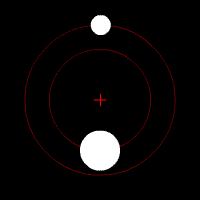With the sheer amount of content for the pilot episode I decided that it'd be best as a double length episode, similar to how many series start. This gives me a better chance to introduce the characters and have enough interesting content to get the audience to want to watch again.
For the second episode the team has exited our solar system and is heading for the nearest star system to us - Alpha Centauri.
Synopsis
With their first mission behind them the crew set off towards the nearest star - Alpha Centauri; a solar system of 2 stars, 5 lightyears away! Along the way the ship's systems detect a 3rd star not visible from Earth that is actually closer to us - Proxima Centauri, which they scan before moving on to their original destination. Shortly after finishing the mission the crew receive a mysterious broken transmission from an unknown source, after analysing the signal they find out that it is an alien message over 3000 years old, but there is no indication of from where the signal came.
Research for the Episode:
This image shows the relative sizes of (from left to right) the Sun, Alpha Centauri A, Alpha Centauri B and finally the red dwarf - Proxima Centauri.
Alpha Centauri is a binary star system, meaning that the system actually has 2 stars orbiting each other!
It is found in the constellation Centaurus.
The 2 stars are each named Alpha Centauri A and B, together making Alpha Centauri AB. There is also a 3rd star - Proxima Centauri only 4.2 lightyears away from us (0.8 lightyears closer than Alpha Centauri AB), it is a red dwarf star much smaller than our sun and only 0.0056% as bright, invisible to the naked eye from Earth.
Alpha Centauri A is approximately 110% the mass of our sun, and 150% as bright, Alpha Centauri B is 90% the mass of our sun and 50% as bright.
Binary star systems appear to 'dance' with each other, in some cases a much smaller star can appear to orbit around a much larger star much like a planet, but in most cases the 2 stars orbit around a point between the 2; known as the barycenter. In the case of the much smaller star orbiting the larger star, the small star appears to do this because the barycenter is inside the larger star.
In the case of Alpha Centauri AB the stars are relatively similar sizes and orbit each other like in the first image. The distance between the 2 stars varies from as close as the Sun and Saturn out to as far away as the Sun and Pluto. The stars take 87 years to complete one full orbit around this barycenter.
Proxima Centauri does not appear to orbit the stars, but is seemingly close enough to be gravitationally tied to them.
It is believed that planets could exist in the system, and given the steady motion of the stars, the star type and age of the stars some astronomers believe that it is one of the most promising candidates for hosting extraterrestrial life (meaning any alien life; from single cell to sentient (intelligent)). These planets could orbit far out around the barycenter of both stars, or closer tied to an individual star.
To be in the habitable zone of Alpha Centauri A a planet would have to be about as far out as half way between Earth and Mars is from our Sun, and for B about as close as Venus.
After Thoughts:
Now that we are out of our own solar system we have really very little knowledge of anything but stars out there and so to keep the series interesting it could be better to include various things which could be theoretically true, such as the existence of planets around the stars etc and possibly direct interaction with other species.






No comments:
Post a Comment